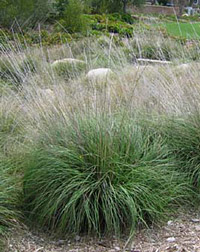
Deer grass (Muhlenbergia rigens) is a native plant suitable for replacing pampasgrass (Cortaderia selloana). Photo: Carolyn Martus
Many invasive plants were originally introduced as ornamentals. The horticultural industry, recognizing this environmental threat, joined conservation biologists at a national workshop in 2001 entitled “Linking Ecology and Horticulture to Prevent Plant Invasions.” This workshop resulted in the “Saint Louis Declaration on Invasive Plant Species,” describing voluntary codes of conduct for professionals and the gardening public.
In 2002, Cal-IPC began developing its ability to educate the California horticultural community about invasive plants. With horticultural partners, we developed a series of “Don’t Plant a Pest” brochures offering landscaping alternatives for invasive plants still used as ornamentals in California. In 2004, Cal-IPC joined with Sustainable Conservation and other NGOs, agencies, universities and industry trade organizations to form the California Horticultural Invasive Prevention (Cal-HIP) partnership. In 2007 Cal-HIP partners established the PlantRight program which promotes voluntary measures for avoiding invasive plants in landscaping.
Invasive Plant Checklist for California Landscaping
Cal-IPC has created a reference guide for avoiding invasive plants in California landscaping, describing both legal requirements and voluntary measures.
PlantRight
PlantRight is a program run by the nonprofit Sustainable Conservation, creating voluntary measures for California’s horticultural community to avoid the use of invasive plants in landscaping. PlantRight brings together partners, including Cal-IPC, to develop lists of plants to avoid and suggests suitable alternatives. They work with commercial growers and retailers to reduce sales of invasive plants, and they support screening tools to help industry identify potential new problem plants before investing in them as a commodity.
Don’t Plant a Pest! program
Cal-IPC developed “Don’t Plant a Pest!” brochures to help homeowners and landscaping professionals select non-invasive plants. These brochures and associated webpages provide suggested alternatives to invasive plants.
Calflora Planting Guide
The Calflora Planting Guide application is a useful tool for planning your landscape project. It suggests which plants will likely grow well at a particular location based on soil, precipitation, climate, and more.
